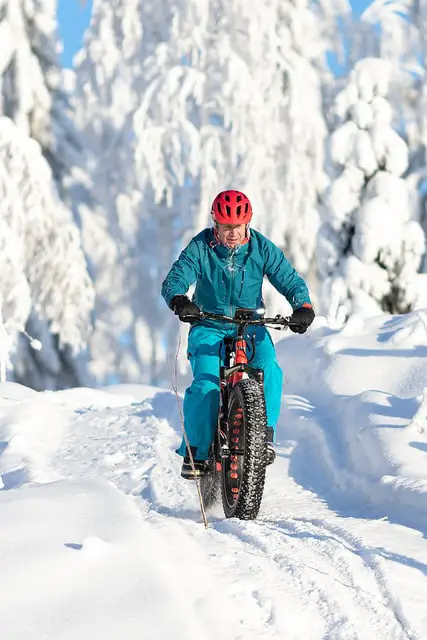Some parts of the world are blessed with eternal sunshine, smooth roads, and free e-Bikes for everyone….and some places have cold winters filled with rain, snow and ice as far as the eye can see. Winter doesn’t have to slow you down (too much) and freeze you off your electric bike. Here are some strategies, gear and tips to keep you on the road riding your ebike year round including winter!
When comparing fair weather ebike riding to riding an electric bike in the winter there are a few key things to consider. A quick rundown on what you’ll find in this article:
- Winter Tires – if you plan to ride in the winter often, you’ll need winter tires.
- Front drive hub motors will generally perform better in snow.
- Care and Maintenance – winter conditions, sand, and salt can be harder on e-Bikes. Plan to up the maintenance and consider a second “winter bike” if you’ll be using it all the time.
- Batteries are the most sensitive component on an e-Bike in the cold. When the temperature drops bike range and performance will be reduced. Keep your battery warm.
- Safety – Slippery conditions require extra care and winter will have darker days. Slow down, careful on corners, keep visible and where a helmet of course!
Winter Tires
If you’re going to be riding an ebike regularly in the winter, then you’ll need proper tires. They are one of the most important parts to winter riding. Proper winter tires give you better performance for two key things:
- Better Traction with water, ice, and snow with a specific tread designed for each condition.
- Better Puncture protection – wet and snowy weather can wash more debris and sharp items onto roads. Winter tires provide better protection for these road conditions with .
Depending on the type of riding you plan to do, the best type winter tire, tread, width, and tire pressure will differ. A brief table to determine what type of tire will best match your type of winter riding:
E-Mountain Bike Tires – trail riding under different surface conditions
| Surface Condition | Tread | Pressure | Width |
| Hard-Packed | Tightly spaced, shorter lugs | Regular | Wider |
| Soft-Muddy | Long, widely spaced lugs | Slightly lower pressure | Narrow (especially for back tire) |
| Snow & Ice | Studded (but these can slip on hard packed surfaces) | Regular | Wider |
| Mixed Terrain | All season, larger side lugs | Slightly lower pressure | Wider (unless there’s lots of mud expected) |
Road Bike Winter Tires – dealing with wet, snow or ice
| Surface Condition | Tread | Pressure | Width |
| Wet Surface | Slick Surface | Regular | Narrow |
| Snow & Ice | Studded (ice) | Lower Pressure | Wider |

Front Drive or Rear drive
Front wheel drive will generally perform better in snow. It has the advantage of pulling the rider forward and will result in a straighter ride, as well as becoming a two-wheel drive when you’re pedalling. I’m not suggesting you go a get a front wheel drive e-Bike if you have a rear wheel drive model – sometimes that’s all you’ve got. Just be aware that you may find your traction may be a bit worse and you might spin out more in the snow.
General Maintenance for winter riding
In colder climates, winter riding will probably involve riding through snow and slush with a nice dash of salt and grit on the roads. Those last two can be hard on your bike components. After riding in these conditions be sure to wipe down components and oil the chain. You can also rust proof those little nooks and crannies of your bike with a rust proof spray.
If you’re considering using an e-Bike regularly in winter for commuting, then you should look at having a specific “cold weather” bike. Regular exposure to sand, grit, and salt from the roads can be really hard on a bikes gears and suspension and you don’t want to destroy your prized ride.
Battery Care
When you’re out riding in colder temperatures, it’s a good idea to protect your battery from the cold and snow with a neoprene cover. Colder batteries won’t perform as well so a cover should help give you a bit more range. On cold days between riding or at the end of the day batteries should be brought inside, that way when you next head out of the house with battery in hand, it’ll have a warmer core and perform better than if it was left outside or in the garage.
Before charging your battery, remember to bring it up to room temperature slowly (don’t put them by a heater to warm up). If you’re commuting in winter with your e-Bike, with the reduced range of the battery you may want to bring your charger with you to work or get a second one to keep at work. Depending on your commute, this may save you from pedalling part of the way home unassisted.
Safety
Winter conditions can be variable and unpredictable, depending on where you live, you could see rain, freezing rain, snow, and sleet all in the same day! You should probably stay off the bike in more extreme conditions of blizzards, freezing rain and black ice – unless you really want to try out your new studded tires. Be sure you are confident riding in difficult conditions, have proper lights, reflective gear, and of course wear your helmet!
Lowering your seat a bit will help keep your feet closer to the ground which will help in more slippery conditions. When you come across a known slippery section, or corners, one technique to increase stability is to stop pedalling, take your feet off the pedals, and hover your feet close to the ground, so that they are already in place to catch you if a tire slips. Let the motor do the work when you’re coasting through these dicey sections.
Remember too, when riding an ebike your speed can be faster that would normally be the case on a regular bike, especially if your ebike has a throttle. Be careful not to go too fast for the conditions in front of you.
Other Gear to make your winter ride better
Fenders! Keep dry by keeping rain, slush, and snow off your back and legs.
Lights – Riding in winter will mean less daylight, earlier sunset, later sunrise. Be prepared with front and rear lights for better visibility and safety on the road.
Heated Gloves or hand warmers – windy, cold temperatures can freeze hand pretty quickly. Why not ride in comfort and style and add eGloves to your e-Bike!
Warm Winter Clothing – dress for the cold, and layer your clothing. If you have a ski or snowboard helmet available, this will keep you warmer than a regular bike helmet and still protect your head.
Keep your stuff dry and out of the elements with waterproof frame bags or panniers.
Hope you’ve found this information useful and you’re able to get out for some fun ebike riding this winter! Any tips you want to share with readers please leave a comment.
